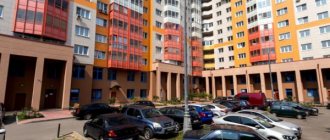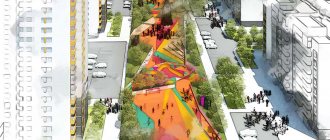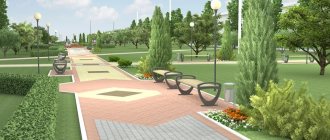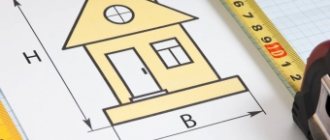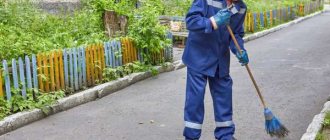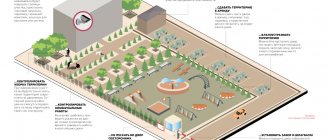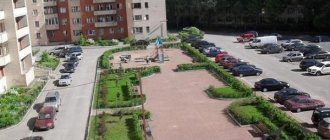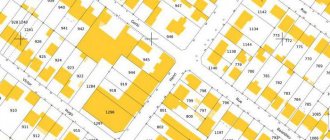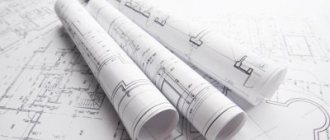Let's consider how government institutions need to reflect in budget accounting the costs associated with carrying out some work to improve their territory.
According to paragraph 36 of Art. 1 of the Civil Code of the Russian Federation, territory improvement is understood as activities for the implementation of a set of measures established by the rules for improvement of the territory of a municipal formation, aimed at ensuring and increasing the comfort of living conditions for citizens, activities to maintain and improve the sanitary and aesthetic condition of the territory of a municipal formation, for the maintenance of territories of settlements and located in such areas of objects, including public areas, land plots, buildings, structures, structures, adjacent territories.
In accordance with clause 3.2 of SP 82.13330.2016[1], landscaping is a set of measures for engineering preparation for landscaping, installation of coverings, lighting, placement of small architectural forms and objects of monumental art, aimed at improving the functional, sanitary, environmental and aesthetic condition plot. For example, landscaping elements are:
— decorative, technical, planning, structural devices;
— plant components;
— various types of equipment and design.
BCC for landscaping expenses
The Ministry of Finance in Letter dated September 13, 2019 No. 02-08-05/70775 explained that, based on the provisions of Order No. 209n[2], expenses for improvement of the territory under the operational management of the institution, depending on the economic content of the expenses incurred for improvement purposes, should reflect:
- expenses for the acquisition of non-financial assets - according to the relevant articles of group 300 “Receipt of non-financial assets” of KOSGU (310 “Increase in the cost of fixed assets”, 340 “Increase in the cost of inventories”);
- expenses for payment for works and services for improvement, forming capital investments - under subarticle 228 “Services, work for the purposes of capital investments” of KOSGU;
- expenses for payment for work and services made for the purpose of maintenance, repair, maintenance, maintenance and (or) restoration of the functional and user characteristics of existing objects - under subarticle 225 “Works, services for property maintenance” of KOSGU;
- expenses not related to repairs and not forming capital investments - under subarticle 226 “Other work, services” of KOSGU.
According to the norms of Order No. 85n[3], expenses for territory improvement should be reflected according to the CWR:
- 243 “Purchase of goods, works, services for the purpose of major repairs of state (municipal) property” - when carrying out landscaping as part of a major repair;
- 244 “Other purchase of goods, works and services” - within the framework of current expenses (including during the creation (construction) of non-permanent buildings).
Next, we will take a closer look at some of the types of landscaping work.
Landscaping
Depending on the work carried out related to landscaping, the following articles (subarticles) of KOSGU apply.
| Article (subarticle) KOSGU | Types of jobs | Base |
| 310 “Increase in the value of fixed assets” | Purchase of trees of operational (fruiting) age | Clause 11.1 of Order No. 209n |
| 346 “Increase in the cost of other inventories” | Purchase of seedlings, seeds, flowers | Clause 11.4.6 of Order No. 209n |
| 347 “Increase in the value of inventories for capital investment purposes” | Purchase of seedlings of perennial plantings | Clause 11.4.7 of Order No. 209n |
| 226 “Other works, services” | Laying out flower beds, planting seedlings and flowers | Clause 10.2.6 of Order No. 209n |
| 228 “Services, work for the purposes of capital investments” | Services for planting trees and seedlings | Clause 10.2.8 of Order No. 209n |
Let us recall that perennial plantings grown in nurseries as planting material, seeds accounted for as part of inventories are reflected in account 105 06 “Other inventories” (clauses 99, 118 of Instruction No. 157n [4]).
The institution's capital investments in perennial plantings are included in its fixed assets annually in the amount of investments related to the areas accepted for operation, regardless of the completion of the entire complex of work (clause 43 of Instruction No. 157n).
Perennial plantings (trees) are taken into account as part of the accounting group “Biological resources” on account 101 37000 “Biological resources - other movable property of the institution” and are taken into account at their original cost (clause 14 of the GHS “Fixed assets” [5], clause 23 , 45 Instructions No. 157n, paragraphs 4, 5 of Instructions No. 162n [6]).
Thus, the initial cost of perennial flowers and trees recognizes the actual investments in grown seedlings, purchased seedlings and the costs of planting them (if any) (clause 15 of the GHS “Fixed Assets”).
In accordance with OK 013 2014 (SNA 2008) [7], perennial plantings belong to the group “Cultivated resources of plant origin that repeatedly produce products” (general code 520.00.00.00). For example, according to code 520.00.10.05, perennial decorative landscaping is reflected, and they are included in the 10th depreciation group with a useful life of over 30 years[8].
According to the introduction to OKOF, this group includes all types of cultivated perennial plantings that repeatedly produce products, including rare plants, whose natural growth and restoration are under the direct control, responsibility and management of specific legal entities, regardless of the age of these plantings. For example:
- landscaping and decorative plantings on streets, squares, parks, gardens, public gardens, on the territory of legal entities, in the courtyards of residential buildings;
- hedges, snow and shelterbelts, plantings to strengthen sand and river banks, gully-beam plantings, etc.;
— cultivated plantings of botanical gardens, other research institutions and educational institutions for research purposes.
The objects of classification are also the green spaces of each park, garden, square, street, boulevard, yard, territory, etc. as a whole, regardless of the number, age and type of plantings, green spaces along the street, road (within the boundaries of a designated area), including individual fences for each planting, plantings for each section (district) of shelterbelts?
The government institution acquired through an accountable entity:
— seeds of perennial flowers worth 200 rubles, from which 20 seedlings were grown;
— soil and fertilizers for flowers in the amount of 250 rubles.
The seedlings were planted on the territory of the institution.
(All data is conditional.)
In budget accounting you need to make the following entries:
| Contents of operation | Debit | Credit | Amount, rub. |
| Funds issued on account | 1 208 34 567 | 1 201 34 610 | 450 |
| Seeds accepted for registration | 1 105 36 346 | 1 208 34 667 | 200 |
| Soil and fertilizers accepted for accounting | 1 105 36 346 | 1 208 34 667 | 250 |
| The sown seeds are written off | 1 106 34 346 | 1 10536 446 | 200 |
| Seedlings accepted for registration (20 pcs.) | 1 105 36 346 | 1 106 34 346 | 200 |
| The planted flower seedlings were written off | 1 106 31 310 | 1 105 36 446 | 200 |
| Spent soil and fertilizers written off | 1 106 31 310 | 1 105 36 446 | 250 |
| Flowers are accepted for accounting as part of fixed assets | 1 101 37 310 | 1 106 31 310 | 450 |
| The cost of planted flowers has been written off | 1 401 20 271 | 1 101 37 410 | 450 |
| Planted flowers have been accepted for off-balance sheet accounting* | 21 | 20 |
* For fixed assets worth up to 10,000 rubles. inclusive, with the exception of library collection objects, depreciation is not accrued (clause 39 of the GHS “Fixed Assets”).
To account for fixed assets in operation by an institution worth up to 10,000 rubles. inclusive of off-balance sheet account 21 (clause 373 of Instruction No. 157n).
Acceptance of fixed assets for accounting is carried out on the basis of a primary document confirming the commissioning (transfer) of the object into operation, in the conditional valuation “one object - 1 ruble.” operation of the facility.
The government agency purchased seedlings of ornamental shrubs (2 pieces) for a total amount of 1,200 rubles. The seedlings were planted on the territory of the institution.
(All data is conditional.)
In budget accounting you need to make the following entries:
| Contents of operation | Debit | Credit | Amount, rub. |
| Seedlings accepted for registration | 1 105 36 346 | 1 302 34 73х* | 1 200 |
| Seedlings paid to supplier | 1 302 34 83х* | 1 304 05 346 | 1 200 |
| Seedlings planted | 1 106 31 310 | 1 105 36 446 | 1 200 |
| Ornamental shrubs have been accepted as part of fixed assets upon reaching operational age** | 1 101 37 310 | 1 106 31 310 | 1 200 |
| The cost of bushes has been written off | 1 401 20 271 | 1 101 37 410 | 1 200 |
| Shrubs have been accepted for off-balance sheet accounting | 21 | 2 |
* According to the corresponding sub-article of KOSGU.
** The concept of operational age can be determined independently by an institution (for example, based on the recommendations of the nursery, special documentation), enshrining it in its accounting policy.
A government agency entered into an agreement with a third-party organization for the provision of landscaping services in the area around the administrative building in the amount of 15,000 rubles.
(Data conditional)
The following entries must be made in accounting:
| Contents of operation | Debit | Credit | Amount, rub. |
| Services provided for landscaping | 1 401 20 226 | 1 302 26 73х* | 15 000 |
| Paid for services rendered | 1 302 26 83х* | 1 304 05 226 | 15 000 |
* According to the corresponding sub-article of KOSGU.
1.2. Landscaping of residential areas
As part of the improvement of residential, house and courtyard areas, it is necessary to plant ornamental plants, create lawns, hedges and other landscaping elements.
They are located taking into account the placement of permanent buildings, structures, structures, and functional areas. Plants should be protected from noise, wind, dust, but not interfere with aeration and air exchange. They can be used as one of the zoning means. For individual objects or areas within courtyard areas, there are special requirements for landscaping.
House strips. They are formed from low trees or shrubs. Plants are planted in small groups. To prevent plantings from shading the windows of the first floor, trees are placed at a distance of at least 5 m from the house, shrubs - 1.5 m or more. The width of the adjacent strips is 3.5-8 m (including the lawn, flowering plants, etc.). Within them, small modular areas are allocated for creating flower beds. Decorative annuals, perennials, and shrubs are distributed according to flowering time. It is possible to use climbing plants in the design of the facade to transition between the territory and the house.
Playgrounds. If they border on driveways, planting strips with a width of 3 m or more are formed along the perimeter. Plants for them are selected so as to maintain good illumination, protect them from wind, dust, and partially shade them. It is better to plant groups of low bushes or trees. If shading is needed, trees are placed along the southern or southwestern border of the playing area. Crowns are openwork or dense, they can be combined. The playground is zoned, highlighting areas that differ in functionality and purpose. To do this, it is better to choose plants of local species - they do not require special care. In such landscaping, you cannot use shrubs whose branches are low, have bright colors, species with thorns, poisonous fruits, or abundant fruiting. To reduce damage to plants, benches, outdoor furniture, low supporting walls, and lightweight fences can be installed around green areas. It is better to use bulk edges with a height of 20-30 cm.
When planning landscaping on children's playgrounds, they take into account indicators of albedo, shading area, total radiation flux, and its transmission by crowns (listed in Table 5).
Albedo measures the reflectivity of a surface. This coefficient is calculated for road surfaces, facades, and materials. This is the relationship between reflected and incoming solar energy. Albedo in ascending order:
- stone ends, crushed stone, cobblestones - 3%;
- asphalt - 4%;
- soil - 4.5%;
- roofing metal - 6%;
- plaster - 8%;
- concrete - 8.5%;
- plywood, red brick - 10%;
- gray granite - 11.5%;
- tree crowns - 12%;
- cement - 13.5%;
- light sand - 14.5%;
- white marble - 16%.
Table 5
Values of total radiation under plant crowns (according to the K.D. Pamfilov Academy of Public Utilities)
| Plant species | Total radiation, cal/cm2/min | |
| under the canopies | In the open | |
| Eastern biota | 0,08 | 1,17 |
| English oak | 0,09 | 1,18 |
| horse chestnut | 0,6 | 1,3 |
| Norway maple | 0,07 | 1,21 |
| Ash green | 0,9 | 1,28 |
Table 6.
Radiation balance ratio for various woody plant species (according to data from the AKH named after K.D. Pamfilov)
| Name of species | Radiation | ||
| Albedo % | skipped from received | ||
| Silver birch | 6,5 | 55,5 | 38 |
| Siberian hawthorn | 1 | 62 | 37 |
| Summer oak | 8,5 | 41 | 50,5 |
| horse chestnut | 10 | 38,5 | 51,5 |
| Norway maple | 6 | 44 | 50 |
| Large-leaved linden black alder | 5 5 | 72 58 | 23 37 |
| Hungarian lilac Balsam poplar | 5 5,5 | 63 56 | 32 39,5 |
| Bird cherry Siberian apple tree | 2 10 | 78,5 36,5 | 19,5 53,5 |
Playgrounds, sports grounds. High mesh fences are installed along their perimeter. Active, active games can be noisy, so when landscaping along the fences on the outside, climbing plants are planted. To provide wind protection, trees or shrubs are placed along the boundaries of the site, arranged in rows or elongated groups. They are placed at a distance of 2 m from the fence or more. This is important so that the branches do not hang over the playing field. Trees are planted on a strip allocated for landscaping, the width of which is at least 3 m. It runs along the boundaries of the site. You can plant tall bushes on it. It is undesirable to choose varieties or species with shiny foliage, abundant fruiting, flying seeds, or early shedding of leaves.
Recreation areas for adults. Staff recommend placing them near existing large trees. If they are not available, landscaping is done so as to partially shade the areas. To do this, you can use pergolas, trellises with climbing plants, and decorative walls for wind protection. In the walking area, lawn-tile paving looks impressive. With this technique, hard surface elements are “sinked” into the lawn.
Household sites. Garbage containers are located here and must be isolated from the rest of the area. To do this, bushes or trees with dense branches are planted along their borders. It is better to place the largest plants on the south side to shade the area. If there is an outdoor area for drying clothes in the yard, it is better to surround it with a low hedge. If there is a place for cleaning, beating dust from carpets, etc., it is surrounded by rows of dust-resistant bushes.
Driveways, walkways. It is possible to create alleys of linden, birch, maple, larch, and large shrubs. At exits from the courtyard area, alleys should not interfere with the view of the road. Low bushes are placed along narrow pedestrian paths and sidewalks, forming green borders. Trees with spreading crowns can be planted along access roads to shade the road and reduce noise and gas pollution in the main area.
Creation of an improvement object
The Ministry of Finance provided recommendations on how to reflect improvement facilities in budget accounting in Letter No. 02-07-10/78244 dated October 11, 2019.
In accordance with clause 3.12 of SP 82.13330.2016, territory improvement objects are territories of various functional purposes where improvement activities are carried out, which, in turn, represents a set of measures for engineering preparation for landscaping, installation of coverings, lighting, placement of small architectural forms and objects of monumental art aimed at improving the functional, sanitary, environmental and aesthetic condition of the site.
According to clause 10 of the GHS “Fixed Assets”, a unit of accounting for fixed assets can be recognized as a part of a property in respect of which one can independently determine the period of receipt of future economic benefits, useful potential, or a part of the property that has a useful life that is different from the rest of the parts (the method of obtaining future economic benefits or useful potential), the cost of which is a significant amount of the total value of the property (structural part of the fixed asset).
Consequently, if, as part of the improvement work (as part of the expenses incurred under subarticle 226 “Other work, services” of KOSGU), objects are created that meet the criteria for recognizing fixed assets (objects with independent functions), the institution’s commission for the receipt and disposal of assets can accept the decision to account for them as separate inventory items within non-financial assets.
If a decision is made to attribute incurred costs to expenses of the current financial year with assignment to the corresponding analytical accounting account of account 1 401 20 200 “Expenses of an economic entity”, information about them must be reflected in the inventory card for accounting for fixed assets (f. 0504031), open in relation to buildings located on the land where landscaping work was carried out.
Mowing the grass
According to clause 10.2.5 of Procedure No. 209n, the institution has the right to attribute the costs of paying for the contract for mowing grass to subarticle 225 “Works, services for property maintenance” of KOSGU.
In addition, an institution can purchase a lawn mower and carry out this work independently.
A lawn mower, according to the norms of clause 7 of the GHS “Fixed Assets,” can be classified as fixed assets under code 330.28.30.40 or 330.28.30.51 OKOF, 2nd depreciation group with a useful life of two to three years inclusive.
Thus, its accounting will be carried out on account 101 34 000 “Machinery and equipment - other movable property of the institution.”
A government agency purchased an electric lawn mower worth 14,000 rubles , which included delivery. There were no additional costs for its acquisition from the institution.
In budget accounting, the purchase of a lawn mower is reflected in the following entries:
| Contents of operation | Debit | Credit | Amount, rub. |
| The lawn mower has arrived from the supplier | 1 106 31 310 | 1 302 31 73х* | 14 000 |
| Lawn mower paid to supplier | 1 302 31 83х* | 1 304 05 310 | 14 000 |
| The lawn mower was registered and put into operation | 1 101 34 310 | 1 106 31 310 | 14 000 |
| 100% depreciation applied to lawnmower | 1 401 20 271 | 1 104 34 411 | 14 000 |
* According to the corresponding sub-article of KOSGU.
The prosecutor went to the park
In court, the prosecutor explained his demands by saying that local officials included “Friendship” in the zone of so-called “public and business development” and with one stroke of the pen excluded the park from the zone of public parks. According to a representative of the supervisory agency, the officials’ decision violates the Urban Planning Code and does not correspond to the city’s master plan. The Supreme Court of Kalmykia upheld the claim of the prosecutor's office and declared the official decision with the verdict against the park invalid.
The city assembly did not agree with this verdict and appealed the decision of its judges to the Supreme Court of the country. Officials asked to cancel the local decision and make a new one - that is, to agree with their plans.
Officials referred to the “compliance of the procedure for amending land use and development rules with the Town Planning Code.” In their opinion, everything they did was impeccable from the point of view of the law.
The Supreme Court of the Russian Federation discussed the arguments of the officials and checked all the materials of the case. The court also heard an opinion from a representative of the Prosecutor General's Office and stated that the local court's decision should be upheld because it was correct and explained why.
The Judicial Panel for Administrative Cases said that the Urban Planning Code (Article 3) stipulates that the legislation on urban planning consists of this code and other federal laws, as well as regulations of both the country and its subjects.
On issues of urban planning activities, municipal legal acts are adopted, which should not contradict the Urban Planning Code.
The Law “On General Principles of the Organization of Local Self-Government in the Russian Federation” and the Urban Planning Code state that the approval of land use and development rules for an urban district, as well as amendments to them, are issues of local importance to the urban district.
Elista is a municipal entity with the status of an urban district. The land use and development rules of Elista were approved by a decision of the city meeting in 2010. The controversial decision of officials on the park introduced changes to the land use rules - the site occupied by “Druzhba” was excluded from the park zone.
The Town Planning Code states that territorial planning documents are mandatory for state authorities and local governments when making decisions. The same Code states that when preparing land use and development rules, the boundaries of territorial zones are established taking into account the zones that are already on the general plan. And the Town Planning Code emphasizes that it enshrines “the principle of the primacy of the master plan over the rules of land use and development.”
From all that has been said, the Supreme Court of the Russian Federation concludes: officials could not change the legal regime of “the purpose of the territory classified as functional zones.” That is, local officials did not have the right to “shove” a public and business development zone into a green area, because this violates urban planning legislation.
